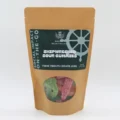Throughout the year, our blog series “Pearls: 30 Lessons Learned on Our 30 Year Journey” will be featuring lessons we’ve learned as an organization throughout the past three decades. These “pearls,” as we call them, illuminate how we’ve survived and thrived for 30 years.
The Dangers of Misunderstanding Success
When I first became the CEO of Women’s Bean Project in 2003, the organization was struggling to be sustainable. There were many issues leading to this struggle, but one of the key factors was the shortage of data being collected to demonstrate our effectiveness. In my first meeting with our grant writer, he lamented the challenge he was having in gathering information to support the case for funding in his grant proposals.
Added to this challenge was that in the absence of data coming from the Bean Project about itself, others in the community – funders, donors, and the community at large – were left to decide what determined whether or not the Bean Project was successful. The problem this created for the Bean Project was that people who didn’t really understand the work we were doing were making decisions about what made us successful. Perhaps they did not understand the challenges faced by the women we hire, or that progress is not always achieved by following one specific path. And because we hadn’t done the work internally to create our determinants of success, we didn’t know exactly how to define our success either.
Nature abhors a vacuum. When we didn’t do a good job of defining what success looks like for us and the women we serve, others did it for us. And the problem with that scenario was that we lost our ability to prove our impact on our own terms. As a result, we had to take the time to define what success looks like for us and our women and then build a program to reach that outcome. To become sustainable, we knew that Women’s Bean Project must have real impact. We realized we had to measure the squishy stuff to show what we do works.
Re-framing How We View Success
Granted, it can be helpful to know how many women complete the 6-9 month program we offer and what percentage go onto jobs in the community and at what hourly rate. Then, as we touch base with the women at 6, 12, 18 and 24 months, tracking how many are still employed and how their lives have changed is even better. However, only measuring what happens at the end of the program and after graduation risks negating the benefits that occur throughout each woman’s tenure at the Bean Project, even if she doesn’t graduate. So, we are trying to do a better job of measuring occurrences for each woman throughout the program; that is, how her feelings change – about herself, the world in which she lives, her ability to affect the world around her.
Yes, it can be very challenging to determine what to measure when many of the outcomes seem squishy. For instance, one of the most significant changes that occurs when a woman successfully completes the program is that she feels worthy of a better life. But how does one measure that feeling? What even are the proxies for measuring this feeling?
What We Believe Success Looks Like
In the end, our program must have real impact. Women’s lives must be changed, and if they aren’t, we should adjust our program model to ensure they will be. More importantly, as a leader in transitional employment social enterprise, the Bean Project must determine what we believe success looks like, be willing to deliver services we believe will lead to that success, then be willing to make adjustments as needed. We cannot throw up our hands and avoid defining our own success because if we do, others will step in and define success for us.
Written by Tamra Ryan, CEO




